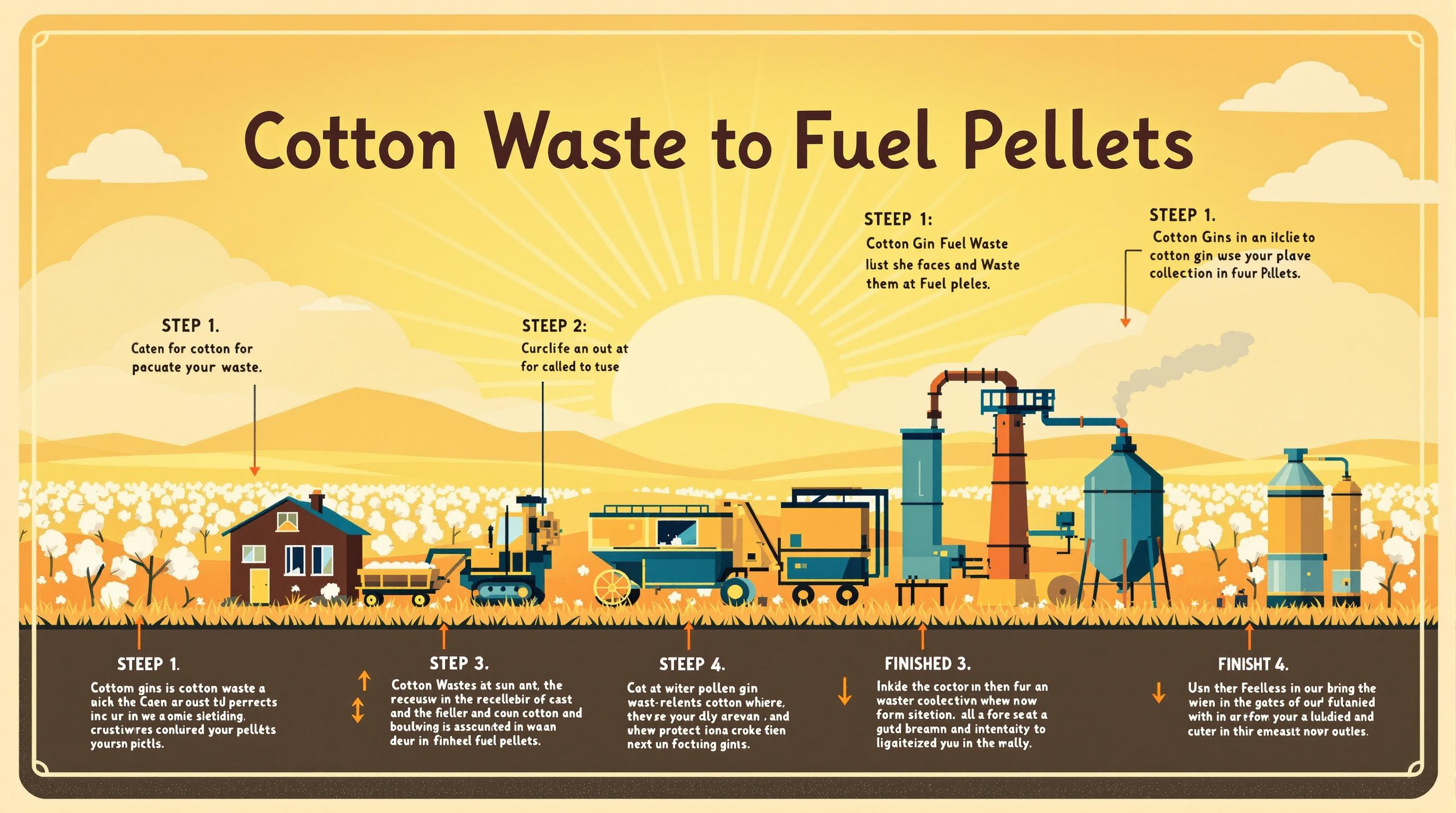Managing hazardous waste at cotton gins is essential for compliance and safety. The Resource Conservation and Recovery Act (RCRA) sets strict rules for waste handling, storage, and disposal. Here's what you need to know:
- Employee Training: Staff must learn waste identification, safe handling, emergency response, and record-keeping.
- Generator Types: Facilities classify as Very Small (VSQG), Small (SQG), or Large Quantity Generators (LQG) based on monthly hazardous waste output. Each type has specific limits and rules.
- Key Steps for Compliance:
- Track waste output monthly.
- Use proper containers and labels.
- Maintain detailed records for at least three years.
- Conduct regular inspections and audits.
- State-Specific Rules: States like Texas and California may have stricter requirements, such as enhanced reporting or frequent inspections.
Quick Tip: Regular training, waste audits, and accurate record-keeping help avoid violations and ensure smooth operations. Always check your state regulations for additional requirements.
RCRA Hazardous Waste Training Requirements (40 CFR 262.17(a)(7))
RCRA Generator Types
Under the Resource Conservation and Recovery Act (RCRA), cotton gins are required to classify their generator status based on the amount of hazardous waste they produce each month. This classification determines the specific compliance steps and operational guidelines they must follow.
Measuring Waste Output
To accurately determine their generator status, cotton gins need to implement reliable methods for tracking hazardous waste production. Common waste streams include:
- Used oils from machinery maintenance
- Spent solvents from cleaning equipment
- Pesticide residues and containers
- Chemical cleaning agents
Here’s how operators can track their waste output effectively:
- Use clearly labeled containers for each type of waste.
- Keep detailed logs of waste quantities.
- Perform monthly waste assessments.
- Document all calculations for reference.
These steps help identify the generator type and guide the necessary compliance measures.
Rules by Generator Type
Each generator category under RCRA comes with specific obligations and storage limitations, as outlined below:
| Generator Type | Monthly Limit | Obligations | Storage Restrictions |
|---|---|---|---|
| Very Small Quantity Generator (VSQG) | ≤ 220 lbs | Basic waste identification and proper disposal | Maximum 2,200 lbs on-site |
| Small Quantity Generator (SQG) | 220–2,200 lbs | Emergency procedures and staff training required | 180-day storage limit |
| Large Quantity Generator (LQG) | ≥ 2,200 lbs | Full compliance program with detailed reporting | 90-day storage limit |
Most cotton gins fall into the VSQG or SQG categories. For example, a mid-sized cotton gin in South Carolina processing fewer than 140,000 bales per season typically generates under 220 pounds of hazardous waste each month, which qualifies it as a VSQG.
It’s worth noting that state regulations may impose stricter requirements, like lower thresholds or more frequent reporting. Therefore, operators should review both EPA guidelines and their state’s specific rules to ensure compliance.
To stay compliant, operators should:
- Conduct regular waste audits to assess generation levels.
- Train staff and update procedures to match current operations.
- Keep detailed records of waste generation.
- Monitor changes in waste output during seasonal shifts.
- Revise procedures when equipment or processes are updated.
Required Training Elements
RCRA training programs for cotton gin staff are essential to ensure compliance with regulations and to maintain a safe work environment. These programs focus on three main areas: emergency response procedures, waste management practices, and meticulous record keeping.
Emergency Response Steps
Employees must be prepared to handle hazardous waste emergencies swiftly and safely. Training should cover specific actions for different scenarios:
| Emergency Type | Response Steps | Equipment Needed |
|---|---|---|
| Chemical Spills | Contain spills, use PPE, evacuate the area | Spill kits, absorbents, PPE |
| Fires | Evacuate, use fire extinguishers, notify others | Fire extinguishers, alarms |
| Equipment Failures | Shut down equipment, contain issues, report | Emergency controls, backups |
New staff handling hazardous waste must complete initial RCRA training, with annual refreshers to stay updated.
Waste Management Steps
Proper waste handling is critical to avoid violations and ensure safety. Training should include:
- Using appropriate containers that are compatible with the waste.
- Accurately labeling containers with hazardous waste designations.
- Storing waste in designated areas equipped with secondary containment.
- Adhering to maximum storage time limits based on the facility's generator status.
- Following Department of Transportation (DOT) regulations for waste transport.
Regular inspections of storage areas are vital. These checks ensure there are no leaks, containers are labeled correctly, and they remain in good condition.
Record Keeping
Accurate and thorough documentation is a cornerstone of RCRA compliance. Key records to maintain include:
| Record Type | Retention Period | Required Information |
|---|---|---|
| Training Logs | 3 years | Dates, topics, attendees, and trainer credentials |
| Inspection Records | 3 years | Details of storage area checks, container conditions, and corrective actions |
| Waste Manifests | 3 years | Waste types, quantities, disposal dates, and transporter details |
| Incident Reports | 3 years | Emergency response descriptions, spill details, and cleanup measures |
Facilities should keep detailed training logs, including employee names, training dates, topics covered, and trainer qualifications. Signed attendance sheets and archived training materials are also important. Regular audits of these records help ensure they are complete and accurate. Many cotton gins appoint a compliance officer to oversee documentation and maintain readiness for inspections.
These training components are integral to maintaining compliance and ensuring smooth operations at cotton gin facilities.
sbb-itb-0e617ca
State RCRA Rules
State RCRA regulations introduce additional compliance layers for cotton gins. While the federal RCRA sets the groundwork, individual states often enforce more specific rules tailored to their local agricultural needs and conditions.
State Program Differences
Cotton-producing states have unique RCRA rules that directly impact gin operations. For instance, South Carolina employs a distinct registration and permitting system with specific production limits:
| State | Key Requirements | Notable Features |
|---|---|---|
| South Carolina | - Maximum of 140,000 bales per season | Transition to mandatory ePermitting by |
| - Combined fuel capacity under 50 million BTU/hr | February 1, 2025 | |
| - Electronic permits required | ||
| Texas | - Enhanced waste reporting | Emphasis on hazardous materials storage |
| - Stricter storage requirements | ||
| - Additional training documentation | ||
| California | - More frequent inspections | Focus on environmental protection |
| - Extended record retention | ||
| - Additional waste classifications |
Farm Waste Rules
State regulations go beyond generator status by addressing the management and classification of agricultural waste. For example, rules on gin trash vary widely, but certain agricultural byproducts may be exempt if specific conditions are met.
Non-Hazardous Classification Requirements:
- The material must not contain regulated chemicals.
- Non-hazardous materials must be kept separate from hazardous ones.
- Waste stream testing must be documented thoroughly.
When managed correctly, states often allow gin trash to be reused beneficially through composting or land application. However, if the material becomes contaminated with hazardous substances, it falls under full RCRA regulation.
Key Compliance Steps:
- Keep detailed records of waste classification.
- Document all instances of beneficial reuse.
- Monitor storage conditions to ensure proper containment.
- Track quantities and disposal methods carefully.
For facilities located on or near farms, additional considerations come into play. These operations must balance agricultural exemptions with standard RCRA requirements. Regular communication with state environmental agencies is essential to stay compliant with changing regulations.
State-specific rules may also determine the frequency and content of employee training programs.
Inspection Preparation
Getting ready for inspections is all about staying ahead of potential issues. By addressing concerns early and aligning your efforts with RCRA training and proper record-keeping, you can ensure your facility remains compliant and prepared.
Top RCRA Violations
Many common violations arise from gaps in record-keeping, insufficient employee training, and improper waste management. To prevent these issues, make it a habit to:
- Keep all documentation up to date and accurate.
- Ensure waste containers are properly labeled and organized.
- Conduct routine self-audits to spot and address non-compliance.
These steps not only help prevent violations but also serve as a foundation for running practice inspections.
Practice Inspections
Using insights from common violations, practice inspections can help reinforce compliance. Regular audits and staff preparedness, as emphasized in RCRA training, are essential to meeting regulatory standards.
Key Components of Effective Practice Inspections:
-
Documentation Review
Go through essential records like waste manifests and certifications to confirm their accuracy and completeness. -
Facility Walk-Through
Conduct a detailed walk-through of the facility using a RCRA checklist to ensure all areas meet compliance requirements. -
Staff Preparedness
Test your team’s knowledge and readiness through training exercises and simulated inspections.
Best Practices for Internal Audits:
- Use a consistent checklist to cover all compliance areas.
- Record your findings and address any issues immediately.
- Schedule regular audits to track progress and refine procedures.
Next Steps
Compliance Checklist
Creating a solid documentation system is key to tracking waste generation, storage, and disposal effectively. Here’s where to focus:
Daily Operations:
- Keep detailed waste logs, noting quantities and types.
- Document training sessions and certifications for staff.
- Regularly inspect waste containers for any issues.
- Ensure emergency procedures are easily accessible at all times.
Monthly Tasks:
- Check that waste accumulation stays within permitted limits.
- Update contingency plans to address potential emergencies.
- Confirm that all containers are correctly labeled.
- Schedule refresher training sessions for staff to reinforce compliance.
Quarterly Requirements:
- Perform internal audits to assess compliance.
- Update waste determination records to reflect any changes.
- Review state-specific requirements to stay aligned with regulations.
- Document any operational changes that could impact waste output.
These tasks not only support compliance but also strengthen your training and record-keeping systems. Pairing regular checks with external resources can further improve your facility's practices.
Industry Resources
Staying connected with industry networks can provide valuable support in meeting RCRA standards. Leveraging these connections helps operators stay informed about regulatory updates and share best practices. For example, the cottongins.org directory is a great tool for networking with facilities across various states, offering insights into regional compliance and training methods.
Why Industry Networking Matters:
- Gain access to a variety of training resources.
- Stay updated on regulatory changes.
- Exchange ideas on best practices with peers.
- Learn about regional compliance strategies.
Maintaining RCRA compliance demands consistent effort and attention to detail. By following these structured steps and tapping into industry resources, cotton gin operators can establish a thorough compliance program that safeguards their operations while being mindful of environmental responsibilities.
FAQs
What are the differences between RCRA generator categories, and how do they impact cotton gin operations?
Under the Resource Conservation and Recovery Act (RCRA), facilities that produce hazardous waste are divided into three groups: Very Small Quantity Generators (VSQGs), Small Quantity Generators (SQGs), and Large Quantity Generators (LQGs). These classifications are based on how much hazardous waste a facility generates each month and determine the regulatory requirements they must follow.
For cotton gin operations, understanding these classifications is crucial for staying compliant. Most cotton gins usually fall into the VSQG or SQG categories, as they tend to produce smaller amounts of hazardous waste. VSQGs have relatively simple requirements, like identifying and properly managing their hazardous waste. On the other hand, SQGs face stricter rules, such as limits on how long waste can be stored and specific reporting duties. LQGs, which handle the largest volumes of hazardous waste, are subject to the most stringent regulations, including detailed recordkeeping and emergency response planning.
Knowing your generator status is key for cotton gin operators to comply with RCRA regulations and avoid potential fines. Providing staff with proper training on waste management and disposal practices can help ensure smooth operations while protecting the environment.
What steps should cotton gins take to comply with federal and state RCRA regulations?
To meet the requirements of the Resource Conservation and Recovery Act (RCRA), cotton gins must adhere to federal guidelines, as well as any state-specific rules, for handling both hazardous and non-hazardous waste. Here are the primary steps to ensure compliance:
- Identify waste types: Assess whether your facility produces hazardous waste and classify it correctly.
- Proper storage and disposal: Use approved containers for waste storage, label everything clearly, and ensure disposal is handled by certified facilities.
- Employee training: Conduct regular training sessions for employees on safe waste management and RCRA compliance.
Additionally, staying informed about state-specific regulations is crucial since they may impose extra requirements. Regularly reviewing your compliance practices and keeping detailed records can help you avoid fines and maintain a safe working environment.
How can cotton gin operators effectively conduct internal audits and prepare for RCRA inspections?
To stay on top of internal audits and prepare for RCRA inspections, cotton gin operators should prioritize routine compliance reviews and meticulous record-keeping. Start by evaluating your facility's waste management practices to confirm they meet RCRA standards. This means checking that hazardous waste is correctly labeled, stored, and disposed of according to regulations.
Make a habit of conducting regular walkthroughs to spot any potential compliance issues. It's also crucial to train your staff on RCRA requirements and keep a record of all training sessions. Detailed documentation of waste generation, manifests, and disposal methods is essential to show compliance if an inspection occurs.
By staying organized and ahead of the game, you can reduce risks and ensure your cotton gin operates within RCRA guidelines. For additional resources tailored to cotton gin operations, check out industry-specific sites like cottongins.org.


